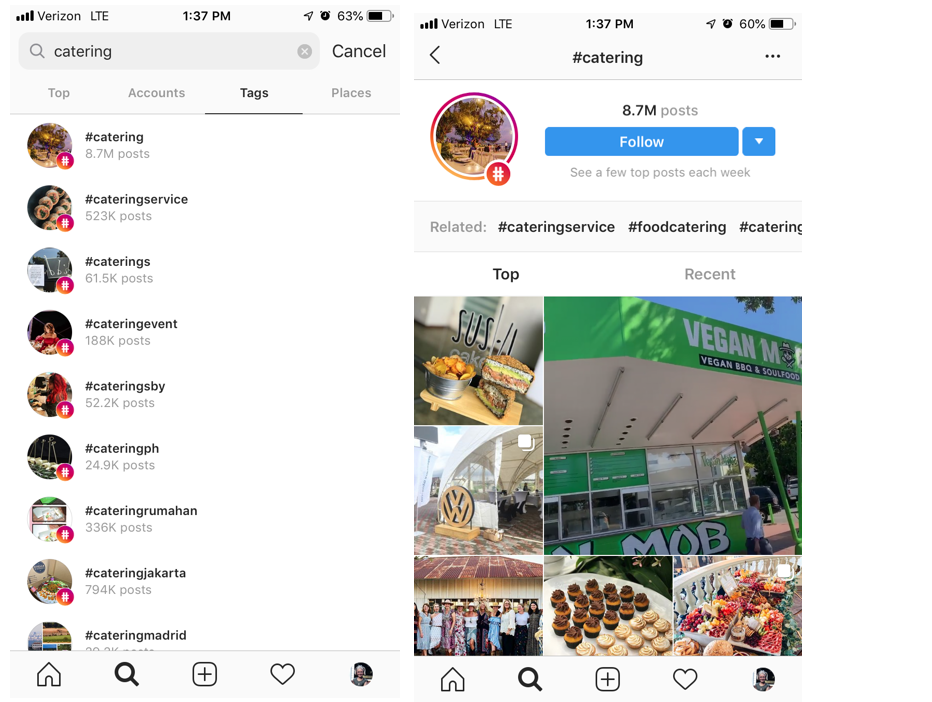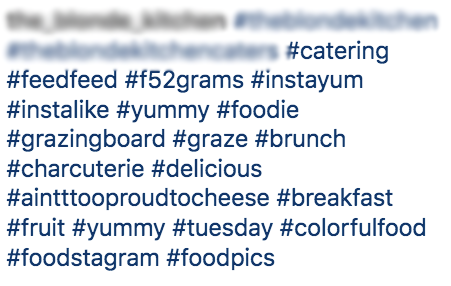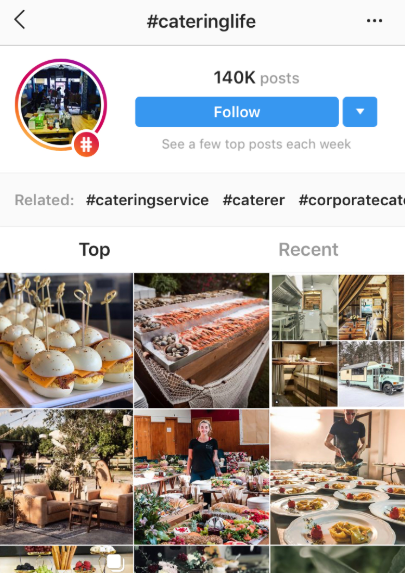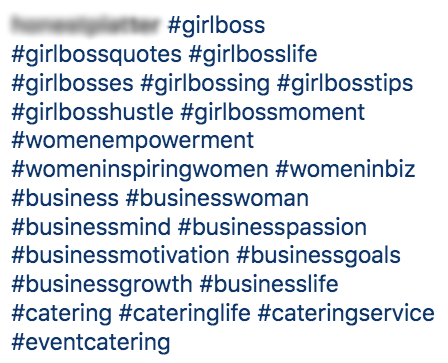Up Your Instagram Game With Effective (and Free) Hashtag Research Strategies
September 25th, 2019 by
#Winning. #Selfie. #Hashtag. While hashtags have crept into our vocabulary (whether sarcastically or not) and may seem like an afterthought, they’re actually effective marketing tools that need to be taken seriously when it comes to your Instagram strategy.
I want you to walk away from this post with a newfound appreciation of hashtags and the confidence to perform hashtag research—trust me, it’s not as complicated as it sounds. And if you already have an Instagram account, you’ve got your most important tool!
Let’s cover the basics before we get into the research steps.
Why Are Hashtags Relevant to Instagram Posts?
Remember, hashtags aren’t just for decoration—especially for business accounts looking to grow followers and create awareness about their brand and services. While you may have a little more fun with hashtags on your personal Instagram (#DoItForTheGram, anyone?), hashtags can help brands get in front of a wider audience and connect with potential customers.
So, how do these little hashtags work their magic?
Even with the perfect combination of good lighting and an engaging caption, a large chunk of Instagram posts goes unseen. 70% of posts, to be exact. Let that sink in.
There’s a big sea of content on Instagram; it’s easy to get lost—but using hashtags can boost your chances of engagement. Adding just one hashtag to a post can increase engagement by 12.6% (but don’t just slap on a hashtag to your post and call it a day)!
Conduct Effective Hashtag Research On Your Own—No Tools Required!
Hashtag research can be a little more fluid than other digital marketing research. Yes, there are steps to follow, but I enjoy this research because there’s room for creativity.
As we walk through hashtag research basics, let’s pretend I’m a small, local catering company looking to expand my business and showcase my delicious work on Instagram. How would I begin my hashtag research?
Go to the search bar, press “Tags,” and type in a keyword related to your industry.
“Catering” is a pretty general hashtag and probably won’t get my little catering company found in a sea of 8.5 million posts. But we’re not stopping there. To find more varied, interesting hashtags related to catering, I’m going to check out some of the top and recent posts that were pulled up in this search. Then I can dig deeper into their hashtags and engagement patterns.
I can also click “Follow” if I want to keep up with the top posts using #Catering—they’ll appear in my Instagram feed.
Let’s dig into this post I found using #Catering and pull out some popular and not-so-popular hashtags that I can use in the future. Because when it comes to hashtag strategy, you want a mix of both!
High- and Low-Density Hashtags
Some of the hashtags in this post are general and widely used on Instagram, such as #Foodie, #Catering, or #Yummy. These are known as “high-density hashtags,” meaning there are more than 500,000 posts on Instagram using that hashtag. While it’s good to use some high-density hashtags to gain new likes and follows, you want to mix them with more specific, targeted hashtags, known as low-density hashtags (used in less than 500,000 posts). There’s less competition for ranking in the top posts with low-density hashtags, helping your brand become more discoverable. Some examples of low-density hashtags in the above posts are #AintTooProudToCheese #GrazingBoard #ColorfulFood.
Always use a mix of high- and low-density hashtags in your post to cast a wide net. To find out the number of posts that have used any given hashtag, simply click on the hashtag, and it’ll take you to a page like the #Catering example. You can also search hashtags if you want a quick number without going to the page.
When compiling your list of hashtags during your research, don’t forget to indicate if it’s high-density or low-density. Your future self will thank you when it’s time to organize them!
Here’s where the fun comes in.
Once you find a few posts from your own initial search, click on hashtags that stand out and see who else is using them. Add those hashtags to your list, and keep going down the rabbit hole!
Here’s a post I found searching through #CateringLife:
Community Hashtags
Notice the mix of hashtags here. We have some catering-related ones (#CateringLife, #EventCatering, #CateringService), and we also have low-density hashtags that speak to a more specific (smaller) audience or community: #GirlBossHustle and #BusinessMind. These are community hashtags that can be used to engage with specific users within a similar business or active community.
It may take some time to find the right community hashtags for your business. Follow a few low-density themed hashtags and observe the other users and business accounts using them—do they align with your brand and goals? Are the accounts engaging with users or one another? Note the hashtags that seem like the best fit for your business. Once you begin experimenting with different community hashtags and engage with other accounts within that community, you may find your tribe and gain more visibility.
Location Hashtags
Location hashtags can help you target a very specific local audience and get in front of Instagram users already following that hashtag. Find location-specific hashtags that combine your targeted area, audience type, and industry. Try different variations of your location (e.g., “NOLAEats,” “NOLACatering,” “NewOrleansFoodie”).
Follow a similar research process as outlined before; don’t be afraid to go down the rabbit hole of accounts by jumping from one hashtag to the next. You never know when hashtag gold will strike!
As you research high-density, low-density, community, and location hashtags, observe (and record!) the number of hashtags, placement, and level of engagement in each post.
Take the time to analyze the posts and accounts your hashtags are coming from:
- Number of hashtags used?
- Number of likes?
- Engaging comments? Responses from the account? No comments?
- Number of followers?
- Hashtags in the comments or caption?
The more you document hashtag use and patterns during your research, the more informed your strategy will be.
Hashtag Categories
I’ve pointed out different types of hashtags throughout the research process—low and high density, location, and community hashtags. While there are more out there, we’re just going to focus on these.
By searching a variety of hashtags types, you can create subcategories for your hashtags.
Now, back to my catering business.
After my research, let’s say I organize my hashtags into four main groups: “Woman-Owned/Small Business,” “Weddings/Corporate Events,” “New Orleans,” and “Industry.” When I plan future posts, I’ll have my hashtags organized and ready to be used according to my post topic.
Remember: you can use multiple categories of hashtags for each post. Focus on hashtags relevant to your industry and post topic—the more relevant hashtags, the more likely your target audience will like, comment, or follow.
Organize Your Research & Create an Ongoing Strategy
No need to purchase special software to organize your research—a simple spreadsheet will do.
Make sure it’s thorough and organizes hashtags in a way that anyone using it will understand. This is especially helpful if more than one person is working on your Instagram posts and overall strategy.
Even if you’re the only one using the spreadsheet, having it clean and organized will be handy when sharing research with others and helping them understand there’s a method to your Instagram-posting madness.
Experiment With, Change Up, and Monitor Your Hashtags!
So, you have your hashtags neatly organized in a spreadsheet. The hard part is over—now it’s time to copy and paste a few of them into your posts and call it a day, right? WRONG! Your hashtag strategy is not a one-and-done ordeal; it’s a strategy, after all.
Strategies need to be ongoing. You need to experiment, observe, and readjust when using hashtags on Instagram. What do I mean by that?
Experiment
- Don’t use the same 5-10 hashtags in every post. I repeat: do not use the same 5-10 hashtags in every post.
- Switch out your hashtags in each post to reach new audience members. You have the chance to cast a net that has the potential to get wider and wider with every post.
Observe
- Consider using an Instagram business account to help monitor post performance. You’ll be able to gain engagement insights for each post, including the number of impressions you received from hashtags alone!
- Even with an Instagram business profile, record notes about your hashtag performance in your spreadsheet since Instagram limits how far back into your insights you can see.
Readjust
- Which hashtags seem to be attracting new followers and encouraging engagement? Any hashtags not performing well (or at all)? Readjust your hashtag use according to your observations.
- Try pairing different hashtags together to see if that improves post performance.
- Think of this step as more informed experimentation. You’re still trying out different hashtag groups and categories, but now you have some observations and notes to back it up.
Repeat
- Surprise! The process doesn’t ever truly end (unless you want less than impressive results). Hashtag use is ongoing for a reason.
- Keep repeating this process with each post. Before you know it, you’ll have an arsenal of hashtags and hefty notes and insights to inform your hashtag strategy.
Ready to Build Your Social Strategy?
While hashtag research can be an easy DIY project, don’t try to balance social media management for your business on top of content creation and marketing. Focus on your business, and Search Influence can do the rest! To learn more about our digital marketing services, speak with a strategist today.
Images:
Hashtag and Heart








Wow! Great post @Emily love the content and the way you explained. Will surely gonna use these tips from today on-words. Thanks for sharing.
Great one Emily! Thanks for sharing such a valuable piece of information on Effective Hashtag Research Strategies for Instagram through your informative article. I must say, Many people, as well as businesses, are scrambling to understand how to make the best use of Instagram benefits to market their business reach online.
Hi Emma, I’m glad you enjoyed the post and found it useful. I appreciate your feedback.
Thanks, Roy, I agree, Instagram is becoming such an effective business tool, but there’s still so much to learn on how to leverage it. I’m excited to watch it grow as a business platform.
Hey Emily, I’ve found that none of the hashtags I’ve added to my posts have worked – the post does not show in the hashtag page. This is the case for every hashtag on every post I’ve made since I started the insta feed. Do you know why this might be? Mine’s a business feed and I need to grow it but I’m struggling to without working hashtags. Any advice would be welcome! Thanks.
Hi Gilbert, since your business account is still fairly small, your posts probably won’t be showing in the “Top” section of that hashtag’s page, but they should be showing in “Recent.” There are a number of reasons they may not be showing, such as using banned hashtags or accumulating fake/questionable followers (not that you are doing these things by any means, just two of the more common reasons posts are hidden).
For your next post, I would suggest double-checking the “Recent” section for each hashtag you’ve used in that post soon after publishing it. If your posts still haven’t appeared in that feed, there may be an underlying issue.
I hope this helps, and best of luck with growing your business!